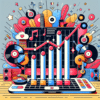Streaming vs. Sales: How Digital Changes the Game on Pop Charts

The music industry has undergone a radical transformation over the last two decades, bringing about seismic shifts in how music is produced, distributed, and consumed. With the rise of platforms such as Spotify, Apple Music, and YouTube, streaming has increasingly dominated the landscape. As a result, the traditional metrics of sales and airplay have struggled to keep pace. This article explores the historical context of music sales, the significant shift towards streaming, the artists pioneering this trend, current trends, and the broader cultural implications of these changes.
Historical Context
Before the digital era, music consumption was predominantly driven by physical sales. Vinyl records, cassettes, and CDs shaped the pop charts, with metrics based on the number of units sold. Billboard magazine's Hot 100 and other charts primarily reflected these sales, relying heavily on the physical distribution of music. For decades, artists and labels focused on album sales as the primary measure of success. In the 1990s and early 2000s, the introduction of the internet began to change how music was distributed, with piracy becoming prevalent and legal digital downloads emerging.
The introduction of iTunes in 2003 revolutionized the industry by allowing consumers to purchase individual songs rather than entire albums. This shift marked the beginning of the decline of physical sales—artists began to see varying levels of success based solely on digital sales. However, the shift to streaming began to gain traction around 2010, presenting a new way to consume music. Research shows that by 2018, music streaming had overtaken digital downloads in terms of revenue, dramatically reshaping the pop charts.
See Also: Nostalgia in Modern Pop: Why We Love Throwback Sounds
Nostalgia in Modern Pop: Why We Love Throwback SoundsKey Artists
Several key artists have emerged as frontrunners in the streaming revolution, illustrating how profoundly these platforms have altered the industry landscape. Drake, for example, has become synonymous with streaming success, often breaking records on platforms like Spotify and Apple Music. His 2015 track "One Dance" was the first song to achieve over a billion streams on Spotify, aligning his success with the immediacy and accessibility of streaming.
Other artists, such as Billie Eilish and Post Malone, have navigated their careers primarily in the streaming age, capitalizing on social media and their digital presence. Their ability to engage with fans through platforms like TikTok further showcases how artists adapt to the new digital economy. Eilish’s debut album, "When We All Fall Asleep, Where Do We Go?", represents a noteworthy example of how streaming algorithms can dictate mainstream success, with her work riding the coattails of viral marketing rather than traditional radio play.
Current Trends
See Also: Pop Song Legends: Celebrating the Greatest Hits that Shaped the Genre
Pop Song Legends: Celebrating the Greatest Hits that Shaped the GenreThe contemporary music landscape is defined by several notable trends that highlight the supremacy of streaming over traditional sales. One of the most significant changes is the frequency of releasing music. Artists are now more inclined to release singles or EPs rather than full albums, considering the fast-paced nature of streaming. This strategy allows musicians to maintain relevance and freshness within the playlists that dominate streaming services.
Moreover, playlists have become crucial when it comes to chart performance. Spotify's curated playlists, such as "Today's Top Hits," can catapult an artist to mainstream success overnight. The algorithms behind these playlists take precedence over radio play and traditional album charts, leading to a populace that increasingly tunes into specific playlists rather than individual tracks or albums.
The availability of user-generated content platforms, especially TikTok, has a rooted effect on how songs go viral and gain traction. Tracks often become popular after being incorporated into memes or challenges, transcending traditional promotional methods. This phenomenon emphasizes the impact of viral marketing in the current digital environment, ultimately driving streaming numbers and chart placements.
Cultural Impact
See Also: Chart Recap: The Pop Songs That Captivated Audiences This Week
Chart Recap: The Pop Songs That Captivated Audiences This WeekThe transition from sales to streaming has profound cultural implications. The democratization of music consumption allows for broader access, providing a platform for independent artists who may not have had the opportunity to gain traction in the traditional sales-driven landscape. Artists can connect directly with their audience through social media, fostering a sense of community while bypassing the gatekeepers of mainstream media.
However, this shift also raises concerns regarding fair compensation for artists. Streaming platforms typically pay a fraction of a cent per stream, leading to criticism of how little artists earn compared to traditional sales where they could have made more revenue per album sold. Prominent musicians from Taylor Swift toRadiohead have publicly challenged streaming models, advocating for better compensation structures that truly reflect an artist's work.
Furthermore, the abundance of music available at a consumer's fingertips poses the risk of over-saturation, where artists struggle to make a lasting impression. In a space where new songs are added every second, the challenge of breaking through the noise is paramount, often requiring artists to be more than just musicians; they must become savvy marketers, social media influencers, and brand ambassadors.
Conclusion: The Significance of Streaming vs. Sales
See Also: Top of the Charts: The Hottest Pop Tracks Taking Over This Month
Top of the Charts: The Hottest Pop Tracks Taking Over This MonthThe debate between streaming and traditional sales encapsulates a critical chapter in the evolution of the music industry. With streaming overtaking sales as the dominant metric for chart success, artists and labels must navigate a landscape influenced by data analytics, playlist placements, and digital engagement. While streaming offers unprecedented access and opportunities for new voices, it also presents challenges regarding compensation and artist visibility.
As the music industry continues to evolve, understanding how digital changes the game on pop charts is essential not just for artists and record labels but for consumers who shape cultural conversations through their listening habits. The future of music lies in a hybrid model that embraces both streaming and physical sales, where each format complements the other instead of being pitted against one another.
FAQs
1. How has streaming changed the way artists release music?
Streaming has led to a trend where artists release singles or EPs more frequently than traditional albums, allowing them to maintain relevance and visibility in rapidly changing trends.
 Chart-Toppers: Analyzing the Best Pop Artists Based on Streaming Success
Chart-Toppers: Analyzing the Best Pop Artists Based on Streaming Success2. What is the impact of playlists on music charts?
Playlists, especially curated ones on platforms like Spotify, play a critical role in determining a song's popularity. Being featured in a popular playlist can significantly boost an artist's streaming numbers and chart performance.
3. Are artists fairly compensated through streaming?
Many critics argue that streaming services do not provide fair compensation for artists, as they pay only a fraction of a cent per stream, significantly less than what artists earn from album sales.
4. Can streaming help independent artists?
Yes, streaming platforms democratize music consumption, providing independent artists with an avenue to reach global audiences without major label backing.
5. How do social media platforms like TikTok impact music trends?
TikTok has become a powerful platform for music discovery, often leading to songs going viral and achieving mainstream success through user-generated content and challenges.
 Streaming Wars: How Spotify and Apple Music are Influencing Pop Music Trends
Streaming Wars: How Spotify and Apple Music are Influencing Pop Music TrendsIf you want to know other articles similar to Streaming vs. Sales: How Digital Changes the Game on Pop Charts you can visit the category Pop.
